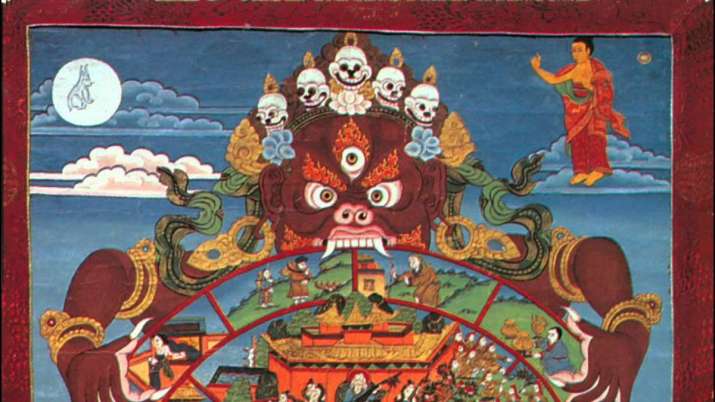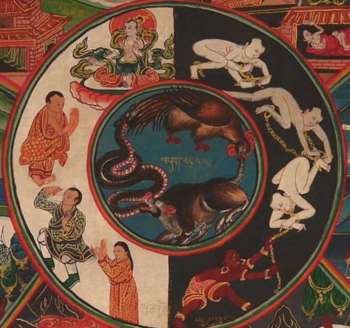In the practice of giving, we can call to mind the Buddhist Wheel of Life; grasped as it is in the claws of Yama, god of death. In the innermost rings of the Wheel are two in particular that can act as reminders this holiday season. In the first is the depiction of greed, hatred, and delusion: the roots of unskillful or unwholesome actions. Can we participate in Christmas free of these? Can we take the season as an opportunity to reflect on our own greed and aversion?
The second ring in the Wheel of Life depicts the outcomes of acting either with these three roots or their opposites: non-greed, non-hatred, non-delusion (or generosity, loving-kindness, and wisdom). Here, morality is played out in literal black and white—as you will see in most paintings of the Wheel of Life, the backgrounds of either side of this ring are black on one side, white on the other. Moral actions lead upward, in this and future lives, toward awakening. Immoral actions draw one downward toward misery in this life and the lower rebirths beyond.
FEATURES|COLUMNS|Western Dharma
A Time of Giving: A Christmas Meditation on Generosity for Buddhists
 Photo by Ben White
Photo by Ben WhiteAs the world becomes increasingly cosmopolitan, with people of all corners of the planet traveling for work, study, and enjoyment, traditions of “East” and “West” become ever more part of one another. In the West, Christianity looms large as both a religious and cultural force. In Asia, Buddhism continues its development in cultures altered radically by modernity.* December, the month of Christmas, offers Buddhists and Christians alike an opportunity to reflect on a topic dear to both traditions: giving.
Christianity has a number of evocative descriptions of generosity: the gift of God’s creation of humankind, the gift of salvation through faith in Jesus Christ, the gift of grace, along with numerous stories of generosity in the lives of Jesus and his followers through history. Central to the story of Christianity is that of Jesus’ birth as a refugee in Bethlehem. To his family came “wise men” from the East bearing gifts. This tradition of generosity, celebrating the birth of Jesus with gifts to those near and dear to us, is itself a gift to the world.
Similarly, Buddhism places great importance on giving (Pali: dana) and generosity (caga). As Maria Heim writes: “It is difficult to overstate the centrality of generosity and gift giving (dāna) in Buddhism. Dāna is a supreme virtue perfected by Bodhisattvas, a key practice of providing economic support to monks and nuns and the Buddhist establishment, and a means of generating religious merit.” (Encyclopedia of Buddhism)
For laypeople, giving is primarily in the form of material goods. Each year after the rains retreat, Theravādin countries still celebrate kathina, a festival in which lay people offer basic goods to monastics such as robes, bowls, new razors for shaving their heads, and toothpaste. Monastics, in turn, give primarily in the form of religious teachings to the laypeople. This may range from recitations of parittas (protection chants) to classes and retreats and the establishment of Buddhist schools and universities. A third and less commonly discussed form of giving is abhayadana, the gift of fearlessness. This may range from the practice of purchasing and freeing animals to teaching specifically in ways that relieve fears and worries in the disciple.
 Yama holding the Wheel of Life. From youtube.com
Yama holding the Wheel of Life. From youtube.comThe purposes for giving in Buddhism are many, from the practical maintenance of the sangha and monastic-laity relations to the highest levels of spiritual practice. As such, giving can be seen as both a beginning to the Buddhist path and as a component of the path in its entirety. In the Ambattha Sutta (DN I.110), the typical Buddhist threefold path of ethics, meditation, and wisdom, is broken down further as “a ‘gradual instruction’ (anupubbikathā), beginning with generosity (dāna), on ethics (sīla), and on heaven (sagga), followed by teachings focused on meditation, namely the disadvantages of sensuality (kāma) and the advantages of renunciation (nekkhamma), and finally the particular Buddhist wisdom of dependent origination (paticcasamuppāda).” (Whitaker and Smith)
This month we might consider some of the ways that Buddhists who live in predominantly Christian countries or with many Christian friends or relatives, and Buddhists who are themselves former Christians might engage in acts of giving.
An initial point of reflection for the contemporary Buddhist is the scourge of consumerism and materialism. Giving gifts can be an act of generosity which breaks down barriers and self-identification, building thoughts of “we” and “us” rather than “I, me, mine” against others. It can also be an act of consumption, driven by ego to find the best gift, to develop a reputation or sense of superiority over others. With the growing climate crisis in mind, it can also fuel the dramatic rise of greenhouse gases in our atmosphere and the growing piles of plastic polluting our oceans.
As Vipassana teacher Phillip Moffit states, “You practice dana to eradicate the attachment that comes from feelings of scarcity and separateness.” True giving in this way breaks down selfishness and comparisons between oneself and others. Yet in our age of advertising and the commercialization of virtually everything, feelings of scarcity and separateness are not easy to overcome.
Generosity must come with an intention of letting go. As the Ambattha Sutta notes, generosity practiced well leads to greater appreciation of the precepts and ultimately turning away from sensuality and all of our fixations on the material world entirely.
The Christmas season thus offers a particularly good time for practice. The practice of generosity can exist on a razor’s edge: fall one way and our giving becomes materialistic, selfish, and contributes to the destruction of our home: Earth. But it can fall the other way: toward a fuller appreciation of caring for others as beings to whom we are inextricably tied in the ever arising and falling away of reality itself.
 The inner circles of the Wheel of Life. From youtube.com
The inner circles of the Wheel of Life. From youtube.comHolding just these two elements of Buddhist teaching in mind, giving can be approached as an opportunity for cultivating goodness and eradicating unwholesome roots of thought. For some this will mean overcoming greed and selfishness. For others, it can be a time to examine aversion to Christianity or people of other religions in general. Either way, it is important to remember that “razor’s edge” and not fall complacently into either aversion or mindless consumption and greed this holiday season.
Doing so, Buddhists can share in the Christmas spirit of giving and perhaps commiserate with the many Christians who bemoan the materialism that has invaded their favorite holiday. In this way, the holiday can be turned away from the usual feast of consumerism and toward a period of interfaith solidarity.
Merit grows for one who gives; No enmity builds up for one restrained; One skilled abandons evil deeds; With greed, hate and delusion exhausted, One attains release, final Nirvana —Udana 8.5
* See David McMahan’s work on Buddhist Modernism. And as cultures and religions mix and grow together, some of these distinctions, such as “West” and “East” are found to have only limited usefulness.
References
Heim, Maria. 2004. Edited by Robert Buswell. “Dāna (Giving)” in Encyclopedia of Buddhism. New York: Macmillan Reference.
McMahan, David. 2008. The Making of Buddhist Modernism, New York: Oxford University Press.
Whitaker, Justin and Smith, Douglass. 2018. “Ethics, Meditation, and Wisdom” in The Oxford Handbook of Buddhist Ethics, Cozort and Shields eds. Oxford University Press: New York.
See More
The Gift of Generosity (Dharma Wisdom of Phillip Moffitt)
Related features from Buddhistdoor Global
How to Want What You Already Have: A Practice for Taking Life As Granted Rather than For Granted
Buddhistdoor View: Cultivating Gratitude this Holiday Season














